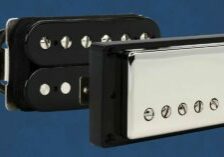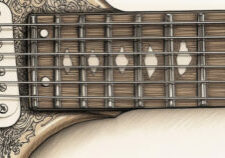When it comes to tuning your electric guitar, the tuners are obviously an important part of the process. We’ll go over how to properly install and adjust electric guitar turners to ensure you get accurate tuning and intonation.
Standard Guitar Tuners
Standard guitar tuners are the most common type of tuner found on electric guitars. They are relatively easy to install and adjust, making them a solid choice for guitarists.
To properly install standard guitar tuners, follow these steps:
- Remove the old tuners: Use a screwdriver to remove the screws holding the old tuners in place. Once the screws are removed, gently pull the old tuners out of their holes.
- Insert the new tuners: Insert the new tuners into the holes left by the old ones. Make sure that they fit snugly and that the screw holes line up with those on your guitar.
- Screw in the bushing: in some cases the bushing will screw down onto the turning posts.
- Screw in the new tuners: Use a screwdriver to screw the tiny placement screws in the new tuners. Make sure that they are tight enough so that they don’t move around, but not so tight that they damage your guitar.
Once you have installed your new standard guitar tuners, it’s time to adjust them for accurate tuning and intonation. See below
Locking Guitar Tuners
Locking guitar tuners are a more advanced type of tuner that are designed to keep your guitar in tune for longer periods of time. They work by locking the strings in place, preventing them from slipping out of tune.
To properly install locking guitar tuners, follow these steps:
- Remove the old tuners: Use a screwdriver to remove the screws holding the old tuners in place. Once the screws are removed, gently pull the old tuners out of their holes.
- Insert the new tuners: Insert the new locking tuners into the holes left by the old ones. Make sure that they fit snugly and that the screw holes line up with those on your guitar.
- Screw in bushing: May not be needed for your turn
- Screw in the new tuners: May not need to do this. A lot of locking tuners don’t have small screws holding them onto the headstock. They sometimes have just one.
Once you have installed your new locking guitar tuners, it’s time to adjust them for accurate tuning and intonation.
To adjust your locking guitar tuners, follow these steps:
- Put the strings through the hole in the tuner posts.
- Some locking tuners will have a knob that you tighten under the headstock to lock the tuner. Pull the string tight but don’t pull hard and just screw the locker.
- Other locking tuners screw in from the top and you have to loosen the top to open the hole in the tuner post. Then you put string through and tighten. Eventually the tuner will lock and the string will begin to wrap around the post.
- Begin the process of tuning your guitar.
Tuning Your Guitar Strings
- Put the strings through the body or bridge hole then over the nut and into hole in the tuner posts.
- Vintage tuners have a hole on top. The trick is to cut your string about 4 inches from the post. That will give you enough slack for the string to wind around the post.
- Check the bridge and saddle to make sure the string is seated in the proper position. Press down the the string after its across the nut to make sure its seated.
- If you hear a clicking sound, then the nut or saddle may need lubricated or deburred.
- Tune your guitar: Use an electronic tuner or tuning app to tune your guitar to standard tuning (EADGBE).
- Stretch the string. Use both hands about 4 inches apart. Push up with your thumbs and slide down the string to stretch it from the saddle to the nut.
- Tune your guitar again
- Repeat stretch one more time. (stretching will save you from having to return another 10 times until the string naturally stretch).
- Tune your guitar. Check each string: Play each string individually and check if it is in tune.
- Repeat for all strings: Repeat step three for all six strings until they are all in tune.
Adjusting Intonation on Your Guitar
Intonation refers to the accuracy of the pitch of each note on your guitar. If your guitar is not properly intonated, it will sound out of tune even if each individual string is in tune. I like to tune and stretch my guitar strings. Then play them without intonation for a bit, often playing a lot of bends to make sure they are fully stretched.
To adjust the intonation on your guitar, follow these steps:
- Tune your guitar: Use an electronic tuner or tuning app to tune your guitar to standard tuning (EADGBE).
- Play the 12th fret: Play the note at the 12th fret on each string and check if it is in tune.
- Adjust the saddle: If the note at the 12th fret is sharp, move the saddle back towards the tailpiece. If it is flat, move the saddle towards the neck.
- Repeat for all strings: Repeat steps two and three for all six strings until they are all properly intonated.
You can always use an electronic tuner or tuning app to ensure that your guitar is properly tuned before making any adjustments.





